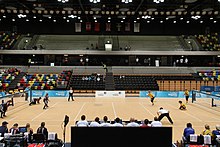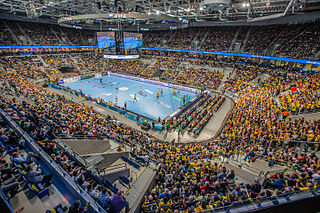
Handball is a team sport in which two teams of seven players each pass a ball using their hands with the aim of throwing it into the goal of the opposing team. A standard match consists of two periods of 30 minutes, and the team that scores more goals wins.
Paralympic football consists of adaptations of the sport of association football for athletes with a physical disability. These sports are typically played using International Federation of Association Football (FIFA) rules, with modifications to the field of play, equipment, numbers of players, and other rules as required to make the game suitable for the athletes.

Torball is a team sport for the blind and vision-impaired and was developed in the 1970s in central Europe. With some similar structures in the rules in the 1980s, it is different to the Paralympic Games team sport of goalball. The sport was recognised by International Blind Sports Federation in 2010.
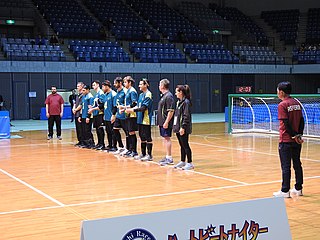
Goalball is a team sport designed specifically for athletes with a vision impairment. Australia commenced its involvement in the sport in 1980. Its men's team has completed in trans-Tasman competitions, the IBSA World Goalball Championships, and the Paralympic Games.

Goalball is a team sport designed specifically for athletes with a vision impairment. Australia commenced its involvement in the sport in 1980. Its women's team has completed in trans-Tasman competitions, the IBSA World Goalball Championships, and the Paralympic Games.
The 2011–12 Australia women's national goalball team, known as the Belles, is a goalball team that played in two Paralympic qualifying competitions and the 2012 Summer Paralympics. The official announcement confirming the 2011–12 team was made in May 2012. The team included Jennifer Blow, Meica Christensen, Michelle Rzepecki, Nicole Esdaile, Rachel Henderson and Tyan Taylor. Most of the players, with the exception of Christensen, were relatively new. Their first competition was the International Blind Sports Federation (IBSA) World Goalball Games, with the top two teams qualifying for the Summer Paralympics. While Australia finished second in its pool, it ended the tournament in sixth place following a loss to Israel. Their second major competition was the ISBA Oceania-Africa Goalball Regional Championships, where they beat New Zealand in the semi-final, and again in the final, to qualify for the London 2012 Paralympic Games.

United States women's national goalball team is the women's national team of the United States. Goalball is a team sport designed specifically for athletes with a vision impairment. The team takes part in international competitions.
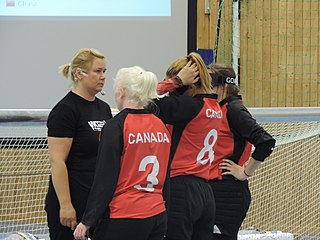
Canada women's national goalball team is the women's national team of Canada. Goalball is a team sport designed specifically for athletes with a vision impairment. The team takes part in international goalball competitions.
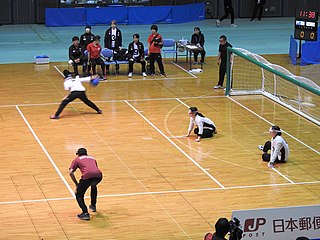
Japan women's national goalball team is the women's national team of Japan. Goalball is a team sport designed specifically for athletes with a vision impairment. Its women's team has internationally completed including at the IBSA World Goalball Championships and the Paralympic Games.
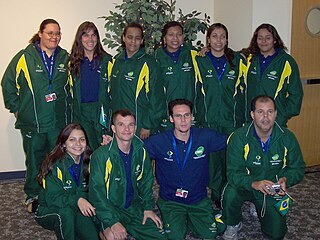
Brazil women's national goalball team is the women's national team of Brazil. Goalball is a team sport designed specifically for athletes with a vision impairment. The team takes part in international goalball competitions.
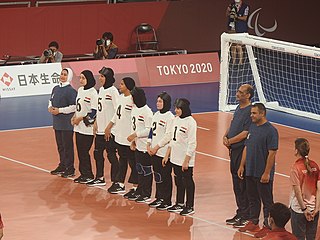
Egypt women's national goalball team is the women's national team of Egypt. Goalball is a team sport designed specifically for athletes with a vision impairment. The team takes part in international goalball competitions.

China women's national goalball team is the women's national team of China. Goalball is a team sport designed specifically for athletes with vision impairment. It takes part in international competitions.

Israel women's national goalball team is the women's national team of Israel. Goalball is a team sport designed specifically for athletes with a vision impairment. It takes part in international competitions. The team won the gold medal at the 2015 IBSA World Games, and the silver medal for Israel at the 2024 Paris Paralympics in the Women's goalball tournament.

Russia women's national goalball team is the women's national team of Russia. It takes part in international goalball competitions. Goalball is a team sport designed specifically for athletes with a vision impairment.

Brazil competed in the 2016 Summer Paralympics in Rio de Janeiro, as host country, from 7 September to 18 September 2016.

Turkey has qualified to send athletes to the 2016 Summer Paralympics in Rio de Janeiro, Brazil, from 7 September to 18 September 2016. Sports the country qualified to compete in include 5-a-side football, archery, goalball, and wheelchair basketball.
Goalball in Cameroon is one of several sports available to people with vision impairments to participate in. It arrived late to the blind sports community in Cameroon, with torball arriving first. It has subsequently, been supported domestically by clubs such as Club for the Blind Youth of Cameroon (CJARC) and PROMHANDICAM Yaounde.
Blind sports in Cameroon include goalball, torball, athletics, African wrestling, judo and 5-a-side football. Blind sports first began in the 2000s, with Cameroon participating in national and international competitions, and hosting workshops. In 2010, a new law was passed to try to increase enforcement of making buildings handicap accessible.
Blind football is played in Australia. The sport was introduced in the country in Victoria in 2014 as a result of Blind Sports Victoria creating a blind football development program. A regional blind football league was created in Victoria in 2015. The following year, the International Blind Sports Federation (IBSA) held a workshop in Melbourne, which was attended by representatives from blind sport organizations in New South Wales. Blind football continued to develop in 2017, governance of the sport was transferred to Blind Sports Australia who wanted to create a national team and develop the sport outside Victoria. That year also saw Australia get is first IBSA recognized blind football referees. In 2018, a talent development search took place in Sydney.

Lithuania men's national goalball team is the men's national team of Lithuania. Goalball is a team sport designed specifically for athletes with a vision impairment. It takes part in international competitions.


